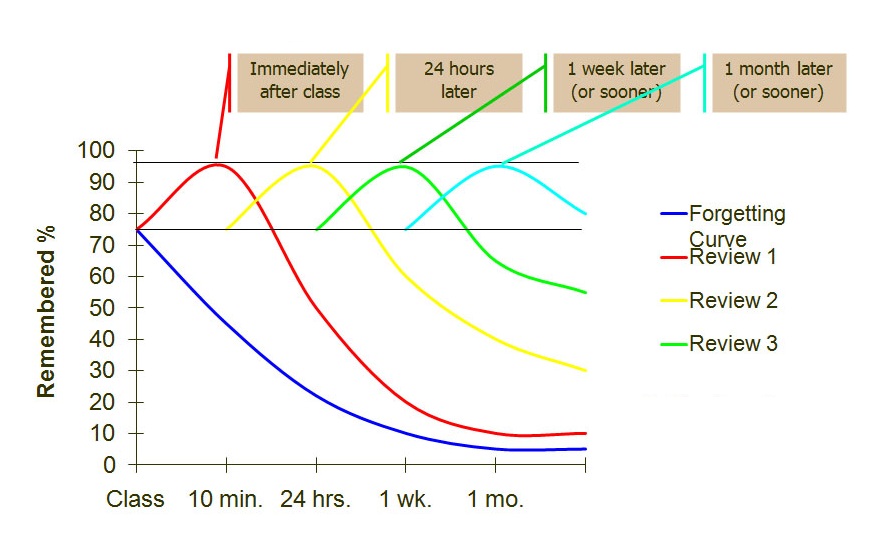Did you get your child to complete stacks of assessment books way before the final examinations started, only to find that they still got mediocre grades? It’s true that cramming at the last minute doesn’t help exam scores, but revising in advance without the proper technique is also a clear sign of “studying hard” without “studying smart”. So how do you get your child (or even yourself) to study smart?
One of the best ways to learn and study effectively is to use spaced repetition. Spaced repetition is a learning technique that incorporates increasing intervals of time between subsequent review of previously learned material, so that it becomes retained in long-term memory. In this article you’ll learn how spaced repetition works, how you can adopt it for your child’s revision, and get some software and tools that utilise spaced repetition for learning.
How Does Spaced Repetition Work?
While repetition is essential for remembering what one has learned, the amount of information that the human brain can absorb falls quickly over time. This is known in psychology as the Ebbinghaus Forgetting Curve:

The reason why our learning efficiency falls so quickly is because the brain needs to process what it has learned. By piling on too much information at one go, the brain’s working memory cannot effectively process everything. However, researchers discovered that if newly learned concepts were revised at specific intervals of time, the information would be most effectively retained in long-term memory. As shown in the Forgetting Curve above, these revision intervals occur at 10 minutes, 1 day, 1 week, and 1 month.
Applying Spaced Repetition to Your Child’s Learning
So how can you plan your child’s revision effectively around spaced repetition? Firstly, set a definite starting and finishing time for the study or revision session. This is important for 2 reasons:
- The brain’s learning efficiency increases when it knows that there is a fixed time for learning and revising
- Having a routine helps your child to develop self-discipline, and you can also allot time for other activities as part of a reward system
Let us illustrate with a 2-hour study session, with around 25 minutes spent on each concept or topic before moving on to the next. Your child can actually revise and practise topics from the 4 main examinable subjects in a 2-hour study session. Here is an example revision timetable that you can adopt:

As you can see, each topic learned is repeated the next day according to the recommended interval for spaced repetition. This timetable should then be repeated the following week, and then a month after that. In the 4 weeks before revising these topics again, you simply repeat the process twice with other topics that your child is learning in school.
Spaced Repetition Tools & Software
In addition to planning your child’s revision timetable around spaced repetition, you can also make use of software and websites that utilise spaced repetition to help your child study smarter. Here are a few of the best that we’ve gathered from the Web:
- The Mnemosyne Project is a free flash card tool that uses an established spacing algorithm to determine which cards to show at what time. You can use it for helping your child improve his vocabulary, and it allows rich content so you can even put images and pronunciation audio on each flash card.
- Anki: similar to Mnemosyne, it comes with iPhone and Android versions.
Conclusion
It is important to remember this: spaced repetition requires dedication on your part to plan and organize your child’s revision topics instead of randomly assigning them questions in an assessment book. For example, if your child is using KooBits EDU, you can track their progress by seeing which topics they have practiced and instruct them to complete books from a certain topic.
In addition, while spaced repetition is a powerful technique for memorization, it cannot replace proper guidance if your child is having trouble understanding a concept in the first place. If you notice that your child is having problems when revising a particular topic – especially when it comes to Math and Science – it is best to help them grasp the concept again instead of pushing them to practise more.
Tags: Kindergarten (5-7), languages, Lower Primary (7-10), Nursery & K1 (3-5), Upper Primary (10-12)
at 3:37 PM
What if I skip the after one day revision and directly revised after 1 week and then 1 month
Also the date of 1 month and is from which day is it 1 month from last revision day (ie one week revision day ) or it is after 1 month of the day on which we learned it
Please reply.
at 5:44 PM
It depends.
For everything that you study, how much and how strongly you remember for each thing differs. If your memory and recall ability for a topic is weaker than that of another topic, then the repetition or re-exposure should be done at a higher frequency than the other’s. That’s why Practicle measures your ability for every question that you do, and automatically spaces relevant questions accordingly in the most optimal way.
Our students have achieved near full marks in SA2 because of this carefully calibrated revision.